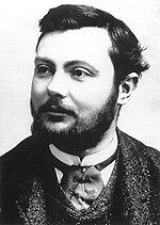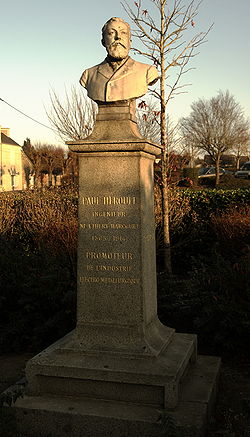
Paul Héroult
Encyclopedia

Aluminium
Aluminium or aluminum is a silvery white member of the boron group of chemical elements. It has the symbol Al, and its atomic number is 13. It is not soluble in water under normal circumstances....
electrolysis
Electrolysis
In chemistry and manufacturing, electrolysis is a method of using a direct electric current to drive an otherwise non-spontaneous chemical reaction...
and of the electric steel
Steel
Steel is an alloy that consists mostly of iron and has a carbon content between 0.2% and 2.1% by weight, depending on the grade. Carbon is the most common alloying material for iron, but various other alloying elements are used, such as manganese, chromium, vanadium, and tungsten...
furnace
Furnace
A furnace is a device used for heating. The name derives from Latin fornax, oven.In American English and Canadian English, the term furnace on its own is generally used to describe household heating systems based on a central furnace , and sometimes as a synonym for kiln, a device used in the...
. He lived in Thury-Harcourt
Thury-Harcourt
Thury-Harcourt is a French commune in the Calvados department in the Basse-Normandie region in northwestern France.Situated in the Orne valley, its surroundings are much like Clécy, but the Rock of Oëtre contrasts with the plateau of Caen to the north....
, Normandy
Normandy
Normandy is a geographical region corresponding to the former Duchy of Normandy. It is in France.The continental territory covers 30,627 km² and forms the preponderant part of Normandy and roughly 5% of the territory of France. It is divided for administrative purposes into two régions:...
.
Christian Bickert said of him
Paul Héroult read Henri Sainte-Claire Deville's treatise on aluminium
Aluminium
Aluminium or aluminum is a silvery white member of the boron group of chemical elements. It has the symbol Al, and its atomic number is 13. It is not soluble in water under normal circumstances....
, when he was 15 years old. At that time, aluminium was as expensive as silver
Silver
Silver is a metallic chemical element with the chemical symbol Ag and atomic number 47. A soft, white, lustrous transition metal, it has the highest electrical conductivity of any element and the highest thermal conductivity of any metal...
.
It was used mostly for luxury items and jewellery. Héroult wanted to make it cheaper.
He succeeded in doing so when he discovered the electrolytic aluminium process in 1886.
The same year, in the United States
United States
The United States of America is a federal constitutional republic comprising fifty states and a federal district...
, Charles Martin Hall
Charles Martin Hall
Charles Martin Hall was an American inventor, music enthusiast, and chemist. He is best known for his invention in 1886 of an inexpensive method for producing aluminium, which became the first metal to attain widespread use since the prehistoric discovery of iron.-Early years:Charles Martin Hall...
(1863–1914) was
discovering the same process. Because of this the process was called the Hall-Heroult process
Hall-Héroult process
The Hall–Héroult process is the major industrial process for the production of aluminium. It involves dissolving alumina in molten cryolite, and electrolysing the molten salt bath to obtain pure aluminium metal.-Process:...
.
Héroult's second most important invention is the electric arc furnace for steel in 1900. The Héroult furnace gradually replaced the giant smelters for the production of a variety of steels.
In 1905, Paul Héroult was invited to the United States as a technical adviser to several companies, and in particular to the United States Steel Corporation.
Paul Héroult is renowned for other major inventions among which a
self-sustained conduit still used to bring water down from mountain heights and across rivers to hydraulic power plants, avoiding the need to build expensive bridges.

